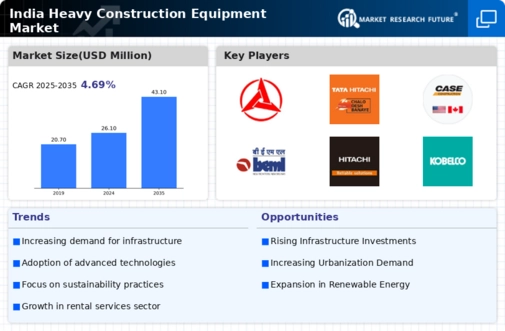Urbanization and Population Growth
Urbanization in India is accelerating, with the urban population projected to reach 600 million by 2031. This rapid urban growth is driving the demand for housing, transportation, and public services, which in turn fuels the heavy construction-equipment market. The need for residential and commercial buildings, along with infrastructure such as roads and bridges, necessitates the use of heavy machinery. Consequently, construction companies are investing in modern equipment to enhance efficiency and productivity. The heavy construction-equipment market is likely to see a significant uptick in demand as urban centers expand and the government pushes for smart city initiatives, which require advanced construction technologies.
Rising Private Sector Participation
The heavy construction-equipment market in India is witnessing increased participation from the private sector, which is becoming a key driver of growth. Private investments in infrastructure projects have surged, with companies seeking to capitalize on government initiatives and public-private partnerships. This trend is expected to lead to a higher demand for heavy construction equipment, as private firms require reliable and efficient machinery to complete projects on time. The market is projected to grow at a CAGR of around 8% over the next five years, driven by this influx of private capital. As a result, equipment manufacturers are likely to focus on developing innovative solutions tailored to the needs of private contractors.
Government Infrastructure Investments
The heavy construction-equipment market in India is currently experiencing a surge due to substantial government investments in infrastructure projects. The Indian government has allocated approximately $1 trillion for infrastructure development over the next five years, which includes roads, railways, and urban development. This financial commitment is likely to stimulate demand for heavy construction equipment, as contractors and construction firms seek to acquire advanced machinery to meet project requirements. Furthermore, the National Infrastructure Pipeline aims to enhance connectivity and promote economic growth, thereby creating a favorable environment for the heavy construction-equipment market. As a result, manufacturers and suppliers are expected to benefit from increased sales and market expansion.
Technological Integration in Construction
The heavy construction-equipment market is increasingly influenced by the integration of advanced technologies such as automation, telematics, and artificial intelligence. These innovations are enhancing operational efficiency and safety in construction projects. For instance, telematics systems allow for real-time monitoring of equipment performance, leading to reduced downtime and maintenance costs. As construction firms in India adopt these technologies, the demand for technologically advanced heavy machinery is expected to rise. This shift not only improves productivity but also aligns with the industry's move towards more sustainable practices. Consequently, manufacturers are likely to invest in research and development to create smarter equipment that meets the evolving needs of the market.
Focus on Sustainable Construction Practices
The heavy construction-equipment market in India is increasingly aligning with sustainable construction practices, driven by both regulatory pressures and market demand. The government is promoting green building initiatives and sustainable infrastructure development, which necessitates the use of eco-friendly construction equipment. This shift is likely to create opportunities for manufacturers to develop and market equipment that meets stringent environmental standards. Additionally, the rising awareness among consumers and businesses regarding sustainability is pushing construction companies to adopt greener practices. As a result, the heavy construction-equipment market may see a growing demand for electric and hybrid machinery, which could reshape the competitive landscape and drive innovation in the sector.






















Leave a Comment